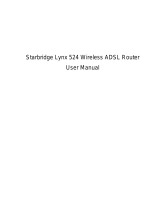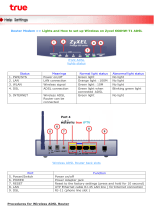Page is loading ...

KW5815A / KW5815B
Wireless ADSL Router
User Manual

Wireless ADSL Router USER MANUAL
NOTICE
This document contains proprietary information protected by copyright, and this Manual
and all the accompanying hardware, software, and documentation are copyrighted. All
rights are reserved. No part of this document may be photocopied or reproduced by
mechanical, electronic, or other means in any form.
The manufacturer does not warrant that the hardware will work properly in all environments
and applications, and makes no warranty or representation, either expressed or implied,
with respect to the quality, performance, merchantability, or fitness for a particular purpose
of the software or documentation. The manufacturer reserves the right to make changes to
the hardware, software, and documentation without obligation to notify any person or
organization of the revision or change.
All brand and product names are the trademarks of their respective owners.
© Copyright 2012
All rights reserved.

Content
1 OVERVIEW ................................................................................................................................ 1
1.1 FEATURES................................................................................................................................ 1
1.2 PACKET CONTENTS ................................................................................................................. 3
1.3 SYSTEM REQUIREMENTS ......................................................................................................... 3
1.4 FACTORY DEFAULTS ............................................................................................................... 4
1.5 WARNINGS AND CAUTIONS ...................................................................................................... 4
2 HARDWARE DESCRIPTION ................................................................................................... 5
3 HARDWARE INSTALLATION ................................................................................................. 7
4 PC CONFIGURATION GUIDE ................................................................................................. 8
4.1 LOCAL PC CONFIGURATION IN WINDOWS 95, 98, ME, XP ...................................................... 8
4.2 LOCAL PC CONFIGURATION IN WINDOWS 2000 ....................................................................... 8
5 WEB-BASED MANAGEMENT GUIDE.................................................................................... 9
5.1 LAN SETTING PAGE ................................................................................................................. 9
5.2 INTERNET ACCESS CONFIGURATION ........................................................................................ 9
5.3 WIRELESS SETTING ............................................................................................................... 16
5.4 MANAGEMENT ....................................................................................................................... 23
APPENDIX: FREQUENT ASKED QUESTIONS...................................................................... 27

Wireless ADSL Router USER MANUAL
1
1 Overview
Thank you for choosing our product. The KW5815A / KW5815B Wireless ADSL
Router uses Broadcom’s CPE solution that fully complies with ADSL, ADSL2,
ADSL2+ and IEEE802.11b/g/n standards. It will provide your SOHO with
convenient Internet access.
1.1 Features
1.1.1 Data rate
Downstream data rate up to 24 Mbps,
Upstream data rate up to 3.5Mbps (With AnnexM enabled)
1.1.2 ADSL Compliance
ITU G.992.1 (G.DMT)
ITU G.992.2 (G.Lite)
ITU G.994.1 (G.hs)
ITU G.992.3 (G.DMT.BIS)
ITU G.992.4 (G.lite.bis)
ITU G.992.5
Compatible with all T1.413 issue 2 (full rate DMT over analog
POTS), and CO DSLAM equipment
TR-069 compliant with ACS
1.1.3 Wireless
Fully IEEE 802.11b & IEEE 802.11g&IEEE 802.11n compatible.
Wireless data rate up to 75 Mbps
Operating in the unlicensed 2.4 GHz ISM band
Supports 64/128 bits WEP, WPA, WPA2, WPA/WPA2-PSK, 802.1x
1.1.4 Network Protocol and Features
Ethernet to ADSL Self-Learning Transparent Bridging

Wireless ADSL Router USER MANUAL
2
Internet Control Message Protocol (ICMP)
IP Static Routing
Routing Information Protocol (RIP, RIPv2)
Network Address Translation (NAT)
Virtual Server, Port Forwarding
Dynamic Host Configuration Protocol (DHCP)
DDNS
Simple Network Time Protocol (SNTP)
VPN pass-through (IPSec/PPTP/L2TP)
Parent control
1.1.5 ATM Capabilities
RFC 1483 Multi-protocol over ATM “Bridged Ethernet” compliant
RFC 2364 PPP over ATM compliant
RFC 2516 PPP over Ethernet compliant
ATM Forum UNI3.1/4.0 PVC
VPI Range: 0-255
VCI Range: 32-65535
UNI 3.0 & 3.1 Signaling
ATM AAL5 (Adaption Layer type 5)
OAM F4/F5
1.1.6 FIREWALL
Built-in NAT
MAC Filtering
Packet Filtering

Wireless ADSL Router USER MANUAL
3
Stateful Packet Inspection (SPI)
Denial of Service Prevention (DoS)
DMZ
1.1.7 Management Support
Web Based GUI
Upgrade or update via FTP/HTTP
Command Line Interface via Telnet
Diagnostic Test
Firmware upgrade-able for future feature enhancement
1.1.8 Operating System Support
WINDOWS 98/SE/ME/2000/XP/VISTA/7
Macintosh
LINUX
1.1.9 Environmental
Operating humidity: 10%-90% non-condensing
Non-operating storage humidity: 5%-95% non-condensing
1.2 Packet Contents
The packet contents are as the following:
ADSL ROUTER x 1
External Splitter x 1
Power Adapter x 1
Telephone Line x 1
Ethernet Cable x 1
CD x 1
1.3 System Requirements
Before using this ROUTER, verify that you meet the following requirements:

Wireless ADSL Router USER MANUAL
4
Subscription for ADSL service. Your ADSL service provider should provide
you with at least one valid IP address (static assignment or dynamic
assignment via dial-up connection).
One or more computers, each contains an Ethernet 10/100M Base-T
network interface card (NIC).
A hub or switch, if you are connecting the device to more than one
computer.
For system configuration using the supplied web-based program: A web
browser such as Internet Explorer v5.0 or later, or Netscape v4.7 or later.
1.4 Factory Defaults
The device is configured with the following factory defaults:
IP Address: 192.168.1.1
Subnet Mask: 255.255.255.0
Encapsulation: LLC/SNAP-BRIDGING or VC/MUX
VPI/VCI: According to local information
1.5 Warnings and Cautions
Never install telephone wiring during storm. Avoid using a telephone during
an electrical storm. There might be a risk of electric shock from lightening.
Do not install telephone jacks in wet locations and never use the product
near water.
To prevent dangerous overloading of the power circuit, be careful about the
designed maximum power load ratings. Not to follow the rating guideline
could result in a dangerous situation.
Please note that telephone line on modem must adopt the primary line that
directly outputs from junction box. Do not connect Router to extension
phone. In addition, if your house developer divides a telephone line to multi
sockets inside the wall of house, please only use the telephone that has
connected with the splitter of ADSL Router when you access the Internet.
Under the above condition, if you also install telephone with anti-cheat-dial
device, please pull out this kind of telephone, otherwise ADSL Router may
occur frequently off-line.

Wireless ADSL Router USER MANUAL
5
2 Hardware Description
Front Panel
LED
Color
Function
PWR
Green
On: Power on
Off: No power
ETH1-4
Green
On: LAN link established and active via LAN port
Blinking: ADSL data activity occurs
Off: No LAN link via LAN port
WLAN
Green
On: The wireless module is ready and idle
Blinking: Data transmitting or receiving over WLAN
Off: The wireless function is off
DSL
Green
On: ADSL link established and active
Quick Blinking: ADSL is trying to establish a
connection
Slow Blinking: No ADSL link
INET
Green
On: IP connected
Blinking: IP connected and IP traffic is passing thru
the device
Off: Modem power off or ADSL connection not
present
WPS
Green
On: WPS connection is established
Blinking: Trying to establish a WPS connection
Off: WPS function is off or no WPS connection

Wireless ADSL Router USER MANUAL
6
Rear panel
Port
Function
DSL
Connect the device to an ADSL telephone jack or splitter
using a RJ-11 telephone cable
ETH1-4
Connect the device to user’s PC's Ethernet port, or to the
uplink port on user’s hub/switch, using a RJ-45 cable
WIFI
Switch the wireless function on or off
RESET
System reset or reset to factory defaults
WPS
A convenient way for WPS set.
ON/OFF
Switch it on or off
POWER
Connect to the supplied power adapter

Wireless ADSL Router USER MANUAL
7
3 Hardware Installation
This chapter shows user how to connect Router. Meanwhile, it introduces the
appropriate environment for the Router and installation instructions.
1. Using a telephone line to connect the DSL port of ROUTER to the Modem port
of the splitter, and using a other telephone line connect user’s telephone to the
PHONE port of the splitter, then connect the wall phone jack to the LINE port of
the splitter.
The splitter comes with three connectors as below:
LINE: Connects to a wall phone jack (RJ-11 jack)
ROUTER: Connects to the DSL jack of ROUTER
PHONE: Connects to a telephone set
2. Using an Ethernet Cable to connect the LAN port of the ROUTER to user’s LAN
or a PC with network card installed.
3. Connect the power cable to the POWER connector on ROUTER, then plug in
the power adapter to the power outlet, and then press the on-off button.
Notes: Without the splitter and certain situation, transient noise from
telephone can interfere with the operation of the Router, and the
Router may introduce noise to the telephone line. To prevent this from
happening, a small external splitter must be connected to each
telephone.

Wireless ADSL Router USER MANUAL
8
4 PC Configuration Guide
4.1 Local PC Configuration in Windows 95, 98, ME, XP
1. In the Windows task bar, click the “Start” button, point to “Settings”, and then
click “Control Panel”.
2. Double-click the “Network” icon.
3. On the “Configuration” tab, select the TCP/IP network associated with user’s
network card and then click “Properties”.
4. In the “TCP/IP Properties” dialog box, click the “IP Address” tab. Set the IP
address as 192.168.1.x (x can be a decimal number from 2 to 254.) like
192.168.1.2, and the subnet mask as 255.255.255.0.
5. On the “Gateway” tab, set a new gateway as 192.168.1.1, and then click
“Add”.
6. Configure the “DNS” tab if necessary. For information on the IP address of the
DNS server, please consult with user’s ISP.
7. Click “OK” twice to confirm and save user’s changes.
8. User will be prompted to restart Windows. Click “Yes”.
4.2 Local PC Configuration in Windows 2000
1. In the Windows task bar, click the “Start” button, point to “Settings”, and then
click “Control Panel”.
2. Double-click the “Network and Dial-up Connections” icon.
3. In the “Network and Dial-up Connections” window, right-click the “Local Area
Connection” icon, and then select “Properties”.
4. Highlight “Internet Protocol (TCP/IP)”, and then click “Properties”.
5. In the “Internet Protocol (TCP/IP) Properties” dialog box, set the IP address as
192.168.1.x (x can be a decimal number from 2 to 254.), and the subnet mask
as 255.255.255.0 and the default gateway as 192.168.1.1. Then click “OK”.
6. Configure the “DNS” tab if necessary. For information on the IP address of the
DNS server, please consult with user’s ISP.
7. Click “OK” twice to confirm and save user’s changes.

Wireless ADSL Router USER MANUAL
9
5 Web-based Management Guide
In order to use the web-based management software it will be necessary to use a
computer that occupies the same subnet as the Router. The simplest way to do this
for many users will be to use DHCP server that is enabled by default on the Router.
5.1 LAN setting page
Launch a web browser, such as Internet Explorer, and then use http://192.168.1.1 to
log on to the setting pages. There is also another user telekom and password
telekom with limited access privilege.
After user log in to the modem, the general status page appears.
5.2 Internet Access Configuration
The setup wizard will guide you to configure the DSL router to access Internet via
PPPoE type.
5.2.1 ADSL Setup
From home page, you can find Advanced Setup option on the left router
configuration page.
1. From Layer2 Interface, click ATM Interface. you can set it up according to the
following steps. You Choose Add, or Remove to configure DSL ATM interfaces.
Click OK
Enter username ‘admin’
and password ‘adslroot’

Wireless ADSL Router USER MANUAL
10
2. Click Add to configure PVC identifier, select DSL latency and select connection
mode according to your local occasion. After the configuration, you need to
click Apply/Save.
3. Click WAN Service from Advanced Setup.
4. Click Add to select a layer 2 interface for this service and then click Next.

Wireless ADSL Router USER MANUAL
11
5. Choose WAN service type, just choose PPPoE for example here. You can enter
your own service description here if you want and then click Next.
6. Input PPP Username & PPP Password and then click Next. The user interface
allows a maximum of 256 characters in the user name and a maximum of 32
characters in the password.

Wireless ADSL Router USER MANUAL
12
PPPoE service name can be blank unless your Internet Service Provider gives you a
value to enter.
Authentication method is default to Auto. It is recommended that you leave the
Authentication method in Auto, however, you may select PAP or CHAP if necessary.
The default value for MTU (Maximum Transmission Unit) is 1500 for PPPoA and 1492 for
PPPoE. Do not change these values unless your ISP asks you to.
Enable FullCone NAT, all requests from the same private IP address and port are
mapped to the same public source IP address and port. Someone on the Internet only
needs to know the mapping scheme in order to send packets to a device behind the
ADSL router.
The gateway can be configured to disconnect if there is no activity for a specific period of
time by selecting the Dial on demand check box and entering the Inactivity timeout.
The entered value must be between 1 minute and 4320 minutes.
The PPP IP Extension is a special feature deployed by some service providers. Unless
your service provider specifically requires this setup, do not select it. If you need to select
it, the PPP IP Extension supports the following conditions:
It allows only one computer on the LAN.
The public IP address assigned by the remote using the PPP/IPCP
protocol is actually not used on the WAN PPP interface. Instead, it is
forwarded to the computer's LAN interface through DHCP. Only one
system on the LAN can be connected to the remote, since the DHCP
server within the ADSL gateway has only a single IP address to assign
to a LAN device.
NAPT and firewall are disabled when this option is selected.
The gateway becomes the default gateway and DNS server to the
computer through DHCP using the LAN interface IP address.
The gateway extends the IP subnet at the remote service provider to the
LAN computer. That is, the PC becomes a host belonging to the same
IP subnet.

Wireless ADSL Router USER MANUAL
13
The ADSL gateway bridges the IP packets between WAN and LAN ports,
unless the packet is addressed to the gateway's LAN IP address.
Use static IPv4 IP address, If the ISP gave you a static IP address, select this option
and enter it in the IP address field.
Bridge PPPoE Frames Between WAN and Local Ports is available when you do not
use PPP IP extension. If you enable this function, LAN hosts can use PPPoE client
software on their computers to connect to the ISP. Each host can have a separate
account and a public WAN IP address.
7. Select a preferred wan interface as the system default gateway.
8. Get DNS server information from the selected WAN interface or enter static DNS
server IP addresses. If only a single PVC with IPoA or static MER protocol is
configured, you must enter static DNS server IP addresses.

Wireless ADSL Router USER MANUAL
14
9. Make sure that the settings below match the settings provided by your ISP. Click on
the Apply/Save button to save your configurations.
5.2.2 LAN Settings
From LAN, Configure the DSL Router’s IP Address and Subnet Mask for LAN
interface. In this page, you can use DHCP (Dynamic Host Configuration Protocol) to
control the assignment of IP addresses on your local network (LAN only).

Wireless ADSL Router USER MANUAL
15
Item
Description
IP address
This is the IP address that other devices on your local network will
use to connect to the modem.
Subnet mask
This defines the size of your network. The default is 255.255.255.0.
Enable IGMP
snooping
IGMP Snooping is a method that actually “snoops” or inspects IGMP
traffic on a switch. When enabled, the switch will watch for IGMP
messages passed between a host and a router, and will add the
necessary ports to its multicast table, ensuring that only the ports
that require a given multicast stream actually receive it.
Use standard mode to flood unknown multicast traffic.
Use blocking mode to discard unknown multicast traffic.
Disable / Enable
DHCP server
The DHCP server assigns an IP addresses from a pre-set pool of
addresses upon request from DHCP client (e.g. your computer). Do
not disable the DHCP server unless you wish to let another device
handle IP address issuance on the local network.
Start / end IP
address
This is the beginning and ending range for the DHCP server
addresses.
Leased time
The amount of time before the IP address is refreshed by the DHCP
server.
Configure the
second IP address
and...
Select this option to let the device use a second IP address on the
LAN interface. You can also use this second IP address to access
the device for management. Enter the LAN IP address of your
device in dotted decimal notation, for example, 10.0.0.1. Type the
subnet mask.
Note: If you want to cancel all modification that you do on the Router, please
select from “ManagementSettingRestore Default Settings” to restore
factory default settings.

Wireless ADSL Router USER MANUAL
16
5.3 Wireless setting
5.3.1 Basic
Option
Description
Enable
wireless
A check box that enables or disables the wireless LAN interfaces. The default is
to enable wireless communications.
Hide Access
Point
Select Hide Access Point to protect the ADSL route access point from detection
by wireless active scans. If you do not want the access point to be
automatically detected by a wireless station, this checkbox should be
deselected.
The station will not discover this access point. To connect a station to the
access point, the station must manually add this access point name in it's
wireless configuration.
In Windows XP, go to the Network>Properties function to view all of the
available access points. You can also use other software programs such as
NetStumbler to view available access points.
Clients
isolation
Enable this item if you don’t want your wireless clients to communicate with
each other.
Network name
(SSID)
Enter a name for user’s wireless network here. SSID stands for Service Set
Identifier. This name must be between 1 and 32 characters long. The default
name is EUnetADSL.
All wireless clients must either detect the gateway or be configured with the
correct SSID to access the Internet.

Wireless ADSL Router USER MANUAL
17
BSSID
Displays the gateway's wireless MAC address. (User may need this address if
user is using WDS or multiple gateways.) Click Apply to save changes.
Country
Drop-down menu that allows selection of specific channel.
5.3.2 Advanced Settings
This page is where user specifies a number of advanced settings for wireless
communications.
/


